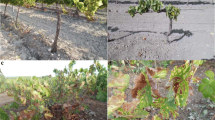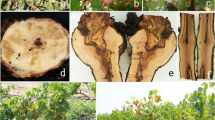Abstract
Grapevine trunk diseases are a major concern to the wine- and table-grape industries worldwide, limiting both vineyard longevity and productivity. Field surveys conducted throughout the grape-growing regions of Arkansas and Missouri revealed the presence of three economically important grapevine trunk diseases including, Botryosphaeria canker, Eutypa dieback and esca. Morphological studies along with multi-gene phylogenetical analyses confirmed the identification of 15 different fungal taxa associated with different vascular symptoms. These include Botryosphaeria dothidea, Diatrypella sp., Diplodia seriata, Dothiorella americana, Eutypa lata, Eutypella vitis, Lasiodiplodia missouriana, Lasiodiplodia viticola, Neofusicoccum ribis, Neofusicoccum vitifusiforme, Pestalotiopsis sp., Pestalotiopsis uvicola, Phaeomoniella chlamydospora, Phomopsis viticola, Schyzophyllum commune, and Togninia minima. All of these represent new records on grapevines in Arkansas and Missouri. Dothiorella americana, L. missouriana and L. viticola are described as new species, and both N. ribis and N. vitifusiforme are first reported as grapevine pathogens in North America. Koch’s postulates confirmed the pathogenicity of all fungal species except S. commune in the interspecific hybrids Vignoles, Chambourcin, Norton, and Traminette. Lasiodiplodia spp., N. ribis, and P. viticola were the most virulent fungi, while D. americana, E. vitis and N. vitifusiforme were considered to be weak pathogens. This research highlights the importance that grapevine trunk diseases have on grapevine health in growing regions where, due to different climatological conditions, interspecific hybrid cultivars are predominantly grown.









Similar content being viewed by others

References
Abdollahzadeh J, Jvadi A, Mohammadi-Goltapeh E, Zare R, Phillips AJL (2010) Phylogeny and morphology of four new species of Lasiodiplodia from Iran. Persoonia 25:1–10
Alves A, Crous PW, Correia A, Phillips AJL (2008) Morphological and molecular data reveal cryptic speciation in Lasiodiplodia theobromae. Fungal Divers 28:1–13
Barber PA, Burguess TJ, Hardy GESJ, Slippers B, Keane PJ, Wingfield M (2005) Botryosphaeria species from Eucalyptus in Australia are pleomorphic, producing Dichomera synanamorphs in culture. Mycol Res 109:1347–1363
Billones RG, Ridgway HJ, Jones EE, Jaspers MV (2010) First report of Neofusicoccum macroclavatum as a canker pathogen of grapevines in New Zealand. Plant Dis 94:1504
Burgess TI, Barber PA, Mohali S, Pegg G, de Beer W, Wingfield MJ (2006) Three new Lasiodiplodia spp. from the tropics, recognized based on DNA sequence comparison and morphology. Mycologia 98:423–435
Carbone I, Anderson JB, Kohn LM (1999) A method for designing primer sets for the speciation studies in filamentous ascomycetes. Mycologia 91:553–556
Carter MV (1988) Eutypa dieback. In: Pearson RC, Goheen AC (eds) Compendium of grape diseases. American Phytopathological Society, St. Paul, pp 32–34
Catal M, Jordan SA, Butterworth SC, Shilder AMC (2007) Detection of Eutypa lata and Eutypella vitis in grapevine by nested multiplex polymerase chain reaction. Phytopathology 97:737–747
Crous PW, Gams W, Wingfield MJ, van Wyk PS (1996) Phaeoacremonium gen. nov. associated with wilt and decline diseases of woody host and human infections. Mycologia 88:786–796
Crous PW, Phillips AJL, Baxter AP (2000) Phytopathogenic fungi from South Africa. Department of Plant Pathology Press, University of Stellenbosch Printers, Stellenbosch, South Africa, 385 p
Damm U, Crous PW, Fourie PH (2007) Botryosphaeriaceae as potentials pathogens of Prunnus species in South Africa, with descriptions of Diplodia Africana and Lasiodiplodia plurivora sp. nov. Mycologia 99:664–680
Dubos B, Larignon P (1988) Esca and black measles. In: Pearson RC, Goheen AC (eds) Compendium of grape diseases. American Phytopathological Society, St. Paul, pp 34–35
Feliciano AJ, Eskalen A, Gubler WD (2004) Differential susceptibility of three grapevine cultivaqrs to Phaeoacremonium aleophilum and Phaeomoniella chlamydospora in California. Phytopathol Mediterr 43:66–69
Fischer M (2002) A new wood-decaying basidiomycete pecies associated with esca of grapevine: Fomitiporia mediterranea (Hymenochaetales). Mycol Prog 1:315–324
Gadoury DM (1995) Controlling fungal diseases of grapevine under organic management practices. NY Agric Exp Stn Special Rep 69:35–44
Glass Louise N, Donaldson GC (1995) Development of primer sets designed for use with the PCR to amplify conserved genes from filamentous Ascomycetes. Appl Environ Microbiol 61:1323–1330
Guba EF (1961) Monograph of Monochaetia and Pestalotia. Harvard University Press, Cambridge
Larignon P, Dubos B (1997) Fungi associated with esca disease in grapevine. Eur J Plant Pathol 103:147–157
Lazzizera C, Frisullo S, Alves A, Phillips AJL (2008) Morphology, phylogeny and pathogenicity of Botryosphaeria and Neofusicoccum species associated with drupa roto f olives in southern Italy. Plant Pathol 57:948–956
Luque J, Martos S, Aroca A, Raposo R, Garcia-Figueres F (2009) Symptoms and fungi associated with declining mature grapevine plants in northeast Spain. J Plant Pathol 91:381–390
Marin H (2010) Fruit production recommendation. Ontario Ministry of Agriculture, Food & Rural Affairs Publication 360, Chapter 6, 11 pp
Mugnai L, Graniti A, Surico G (1999) Esca (black measles) and brown wood-streaking: two old and elusive diseases of grapevines. Plant Dis 83:404–418
Pavlic D, Slippers B, Coutinho TA, Gryzenhout M, Wingfield MJ (2004) Lasiodiplodia gonubiensis sp. nov., a new Botryosphaeria anamorph from native Syzygium cordatum in South Africa. Stud Mycol 50:313–322
Pavlic D, Wingfield MJ, Barber P, Slippers B, Hardy GESJ, Burgess TI (2008) Seven new species of the Botryosphaeriaceae from baobab and other native trees in Western Australia. Mycologia 100:851–866
Pavlic D, Slippers B, Coutinho TA, Wingfield MJ (2009) Molecular and phenotypic characterization of three phylogenetic species discovered within the Neofusicoccum parvum/N. ribis complex. Mycologia 101:636–647
Pearson RC (1982) Protection of grapevine pruning wounds from infection by Eutypa armeniacae in New York. Am J Enol Vitic 33:51–52
Petit E, Gubler WD (2005) Characterization of Cylindrocarpon species, the cause of black foot disease of grapevine in California. Plant Dis 89:1051–1059
Phillips AJL (2002) Botryosphaeria species associated with diseases of grapevines in Portugal. Phytopathol Mediterr 41:3–18
Phillips AJL, Alves A, Correia A, Luque J (2005) Two new species of Botryosphaeria with brown, 1-septate ascospores and Dothiorella anamorphs. Mycologia 97:513–529
Pitt WM, Huang R, Trouillas FP, Savocchia S, Steel CC (2009) Evidence that Eutypa lata and other diatrypaceous species occur in New South Wales vineyards. Australas Plant Pathol 39:97–106
Pitt WM, Huang R, Steel CC, Savochia S (2010) Identification, distribution and current taxonomy of Botryosphaeriaceae species associated with grapevine decline in New South Wales and South Australia. Aust J Grape Wine R 16:258–271
Punithalingam E (1979) Phomopsis viticola. Descriptions of pathogenic fungi and bacteria, No. 635. Kew, Surrey, England: Commonwealth Mycological Institute. 2 p
Ramsdell DC (1994) Common diseases of the grapevine in Michigan. Michigan State University Extension Fruit IPM Extension Bulletin 1732
Rayner RW (1970) A mycological colour chart. Kew, Surrey: Commonwealth Mycological Institute & British Mycological Society. 34 p
Rolshausen PE, Gubler WD (2005) Use of Boron for the control of Eutypa dieback of grapevines. Plant Dis 89:734–738
Rolshausen PE, Wilcox W (2009) Identifying the causes of wood cankers and branch dieback in eastern U. S. vineyards. Phytopathol Mediterr 48:164
Rolshausen PE, Úrbez-Torres JR, Rooney-Latham S, Eskalen A, Smith RJ, Gubler WD (2010) Evaluation of pruning wound susceptibility and protection against fungi associated with grapevine trunk diseases in California. Am J Enol Vitic 61:113–119
Rooney-Latham S, Eskalen A, Gubler WD (2005) Teleomorph formation Phaeoacremonium aleophilium, cause of esca and grapevine decline in California. Plant Dis 89:177–184
Scheck HS, Vasquez SJ, Fogle D, Gubler WD (1998) Grape growers report losses to black foot and grapevine decline. Calif Agric 52:19–23
Siebert JB (2001) Eutypa: the economic toll on vineyards. Wines Vines 4:50–56
Sosnowski MR, Creaser ML, Wicks TJ, Lardner R, Scott ES (2008) Protection of grapevine pruning wounds from infection by Eutypa lata. Aust J Grape Wine R 14:134–142
Swofford DL (1999) PAUP*. Phylogenetic Analysis Using Parsimony (*and other methods). Version 4.0b4a. Sinauer Associates, Sunderland, MA
Thompson JD, Higgins DG, Gibson TJ (1994) CLUSTAL W: Improving the sensitivity of progressive multiple sequence alignment through sequence weighting, position-specific gap penalties and weight matrix choice. Nucleic Acids Res 22:4673–4680
Trouillas FP, Gubler WD (2004) Identification and characterization of Eutypa leptoplaca, a new pathogen of grapevines in northern California. Mycol Res 108:1195–1204
Trouillas FP, Gubler WD (2010) Pathogenicity of Diatrypaceae species in grapevines in California. Plant Dis 94:867–872
Trouillas FP, Úrbez-Torres JR, Gubler WD (2010) Diversity of diatrypaceous fungi associated with grapevine canker diseases in California. Mycologia 102:319–336
Trouillas FP, Pitt WM, Sosnowski MR, Huang R, Peduto F, Loschiavo A, Savocchia S, Scott E, Gubler WD (2011) Taxonomy and DNA phylogeny of Diatrypaceae associated with Vitis vinifera and other woody plants in Australia. Fungal Divers (In press)
Úrbez-Torres JR, Gubler WD (2009) Pathogenicity of Botryosphaeriaceae species isolated from grapevine cankers in California. Plant Dis 93:584–592
Úrbez-Torres JR, Gubler WD (2011) Susceptibility of grapevine pruning wounds to infection by Lasiodiplodia theobromae and Neofusicoccum parvum. Plant Pathol 60:261–210
Úrbez-Torres JR, Leavitt GM, Voegel TM, Gubler WD (2006) Identification and distribution of Botryosphaeria species associated with grapevines cankers in California. Plant Dis 90:1490–1503
Úrbez-Torres JR, Leavitt GM, Guerrero JC, Guevara J, Striegler K, Allen A, Gubler WD (2007) Identification of fungal pathogens associated with grapevine cankers in the main grape-growing areas of the United States and Mexico. Phytopathol Mediterr 46:S109–S110
Úrbez-Torres JR, Leavitt GM, Guerrero JC, Guevara J, Gubler WD (2008) Identification and pathogenicity of Lasiodiplodia theobromae and Diplodia seriata, the causal agents of bot canker disease of grapevines in Mexico. Plant Dis 92:519–529
Úrbez-Torres JR, Adams P, Kamas J, Gubler WD (2009) Identification, incidence, and pathogenicity of fungal species associated with grapevine dieback in Texas. Am J Enol Vitic 60:497–507
Úrbez-Torres JR, Peduto F, Gubler WD (2010a) First report of grapevine cankers caused by Lasiodiplodia crassispora and Neofusicoccum mediterraneum in California. Plant Dis 94:785
Úrbez-Torres JR, Battany M, Bettiga LJ, Gispert C, McGourty G, Roncoroni J, Smith RJ, Verdegaal P, Gubler WD (2010b) Botryosphaeriaceae species spore-trapping studies in California vineyards. Plant Dis 94:717–724
Úrbez-Torres JR, Bruez E, Hurtado J, Gubler WD (2010c) Effect of temperature on conidial germination of Botryosphaeriaceae species infecting grapevines. Plant Dis 94:1476–1484
van Niekerk JM, Crous PW, Groenewald JZ, Fourie PH, Halleen F (2004) DNA phylogeny, morphology and pathogenicity of Botryosphaeria species on grapevines. Mycologia 96:781–798
Vasquez SJ, Gubler WD, Leavitt GM (2007) Economic loss in Califonria’s table grape vineyards due to measles. Phytopathol Mediterr 46:118
Weber EA, Trouillas FP, Gubler WD (2007) Double-pruning of grapevine: a cultural practice to reduce infection by Eutypa lata. Am J Enol Vitic 58:61–66
White TJ, Bruns T, Lee S, Taylor J (1990) Amplification and direct sequencing of fungal ribosomal RNA genes for phylogenetics. In: Innis MA, Gelfand DH, Sninsky JJ, White TJ (eds) PCR Protocols, A guide to methods and applications. Academic Press, San Diego, pp 315–322
Acknowledgments
This work was partially funded by a grant from the Missouri Wine and Grape Board. The authors thank E. Bergmeier and A. Allen (Institute for Continental Climate Viticulture & Enology, University of Missouri, Columbia, Missouri) for providing the plant material for the pathogenicity assays and valuable pictures of the different grapevine symptoms, respectively.
Author information
Authors and Affiliations
Corresponding author
Rights and permissions
About this article
Cite this article
Urbez-Torres, J.R., Peduto, F., Striegler, R.K. et al. Characterization of fungal pathogens associated with grapevine trunk diseases in Arkansas and Missouri. Fungal Diversity 52, 169–189 (2012). https://doi.org/10.1007/s13225-011-0110-4
Received:
Accepted:
Published:
Issue Date:
DOI: https://doi.org/10.1007/s13225-011-0110-4



